Béchamel based Creamy Shrimp Croquettes are as popular as Korokke (Japanese Potato and Ground Meat Croquettes) in Japan. They might look a bit fiddly but actually it doesn’t take long to make them. Unlike potato-based croquettes, you can enjoy the rich creamy flavour without pouring a sauce over the top.
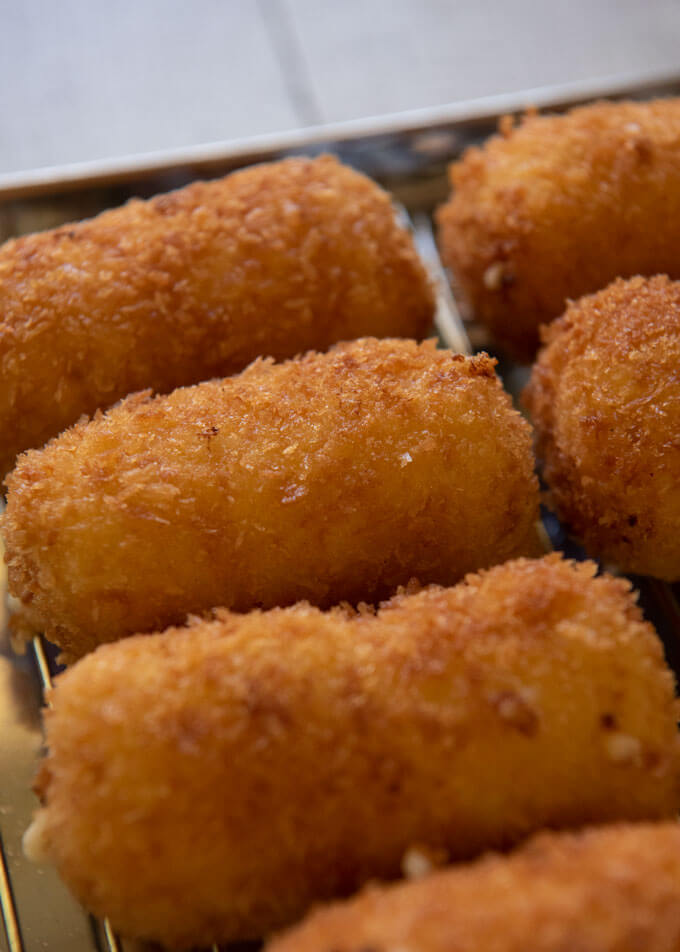
Japanese people do like croquettes and so do I. There are so many different kinds of Japanese croquettes sold at food stores in Japan and they are basically divided into two groups – potato-based croquettes and béchamel-based croquettes.
The potato croquettes are generically called ‘poteto korokke’ (ポテトコロッケ) and the béchamel-based creamy croquettes are called ‘kurīmu korokke” (クリームコロッケ). By adding different ingredients to the base, each kind of croquette is given a unique name.
For example, mixed vegetables in potato-based croquettes are called ‘yasai korokke’ (野菜コロッケ) . If vegetables are in béchamel sauce, it becomes ‘yasai kurīmu korokke’ (野菜クリームコロッケ). The word ‘yasai’ (野菜) means vegetables.
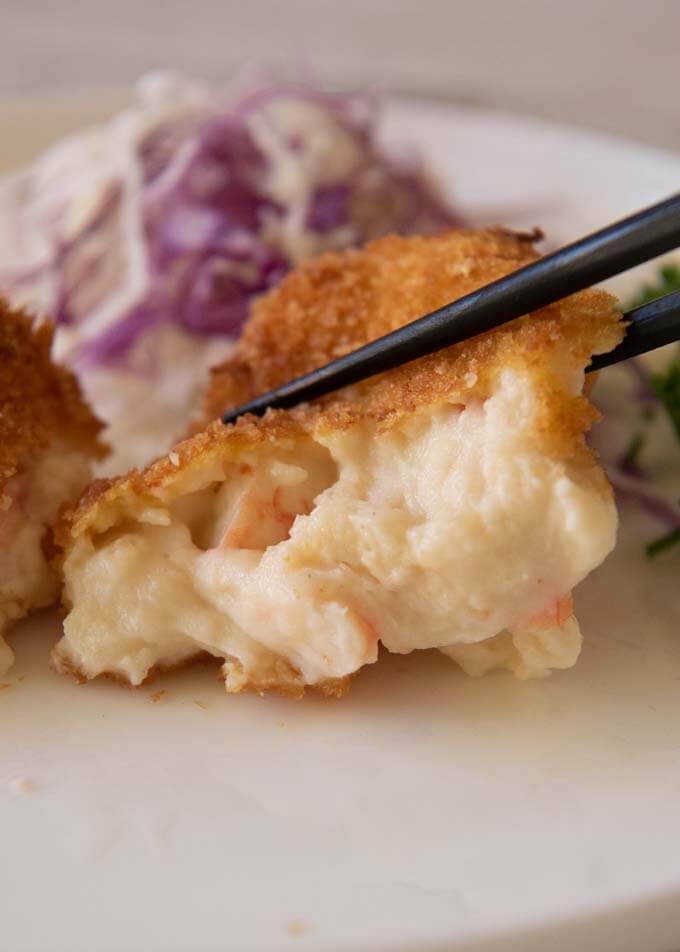
Depending on the ingredients that go with béchamel sauce, the method of making the croquette base varies slightly. But fundamentally, it’s a mixture of béchamel sauce and the key ingredients with flavouring.
Flavouring of My Creamy Shrimp Croquettes
Some recipes add chicken stock powder to give a good flavour to the béchamel sauce. Some recipes sauté prawns and onions first with a small amount of wine, then mix into to the béchamel sauce.
I tried both methods, but I wasn’t happy with the prawn flavours in the sauce. So, I decided to cook fresh prawns (with shells on) in milk to extract a good prawn flavour, then use the milk to make béchamel sauce (see the first photo of step-by-step photo in the next section). The cooked prawns are peeled, chopped and mixed into the béchamel sauce.
This is faster than sautéing the prawns separately, is less oily and gives a good prawn flavour to the sauce. When cooking the prawns in milk, I also add a small amount of onions, a bay leaf, nutmeg, salt and pepper.
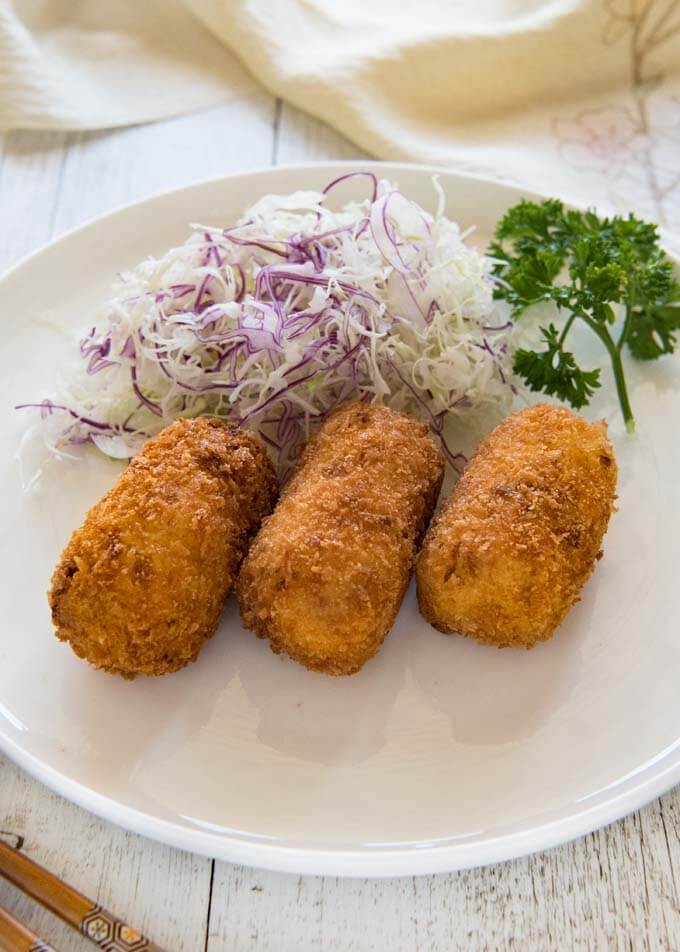
Key Points to Shape Béchamel Sauce into Croquettes.
Compared to the béchamel sauce used to make Macaroni Gratin, the sauce for the creamy croquettes is much thicker. The amount of milk used in this recipe is less for the amount of roux made with butter and flour.
But while it is still warm, the sauce is too soft to shape. There are a couple of things you can do to make your life easier.
- Chill the mixture in the fridge or freezer. When chilled, the butter in the sauce hardens and the mixture becomes like a dough. Spread the béchamel mixture in a tray into a square or a rectangle shape (so that you can divide it into equal portions easily). Cover the surface with cling wrap to prevent it from drying and chill it.
- Oil your hands to shape the mixture into a fat log shape (see the photo below). Without it, you will find that the mixture sticks to your hands.
- As soon as you make fat logs, coat them in flour, egg and panko breadcrumbs. The longer you leave them, the softer the mixture gets (unless your room is super cold!) and this will make it more difficult to keep the shape.
The inside of the croquette is already cooked so you don’t need to deep fry for a long time. You only fry croquettes for about a couple of minutes at 175-180C/350F until the breadcrumbs become golden brown.
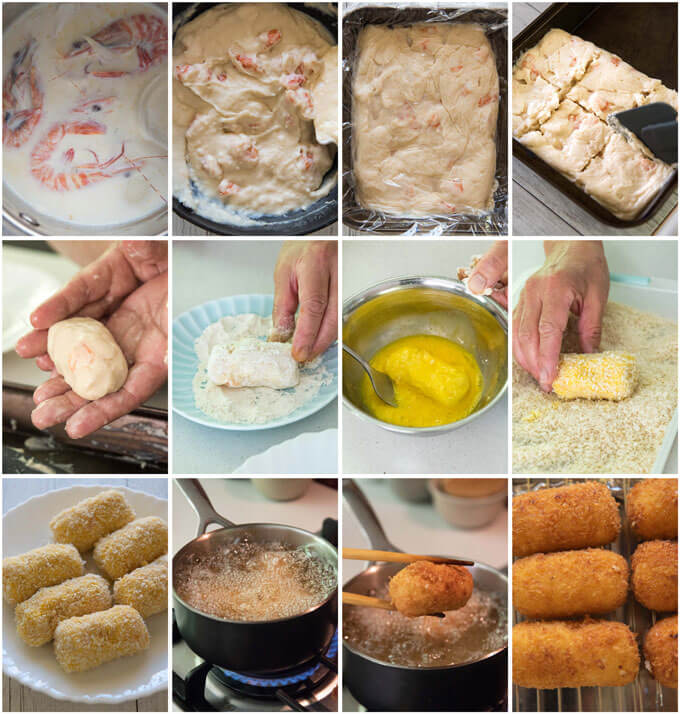
Perfect Frozen Food
The beauty of this dish is that you can make croquettes ahead of time, freeze them and re-heat them later. You can freeze them either before deep frying or after deep frying. Frozen croquettes keep about a month.
Freeze Before Frying
Storage: Wrap each crumbed croquette in cling wrap and place them on a flat tray without overlapping. Once frozen, you can pile them up in a bag or a container to store.
Cooking: Defrost in a microwave for 1 minute (per croquette), then deep fry at 175-180C/350F until golden brown. Do not overcrowd the oil with too many croquettes.
Freeze After Frying
Storage: Wrap each croquette in cling wrap and place them on a flat tray without overlapping. Alternatively, place croquettes without touching each other in a container with a lid and freeze. Once frozen, you can pile them up in a bag or a container to store.
Reheating: Microwave for a minute to defrost (per croquette), then place them on a tray with a rack or lined with scrunched aluminium foil. Bake at 200C/392F for 15 minutes.
Creamy inside and crunchy outside, this is a great way to enjoy the Japanese version of a Western style dish. Best to eat while hot – see how soft the inside of the croquette is!
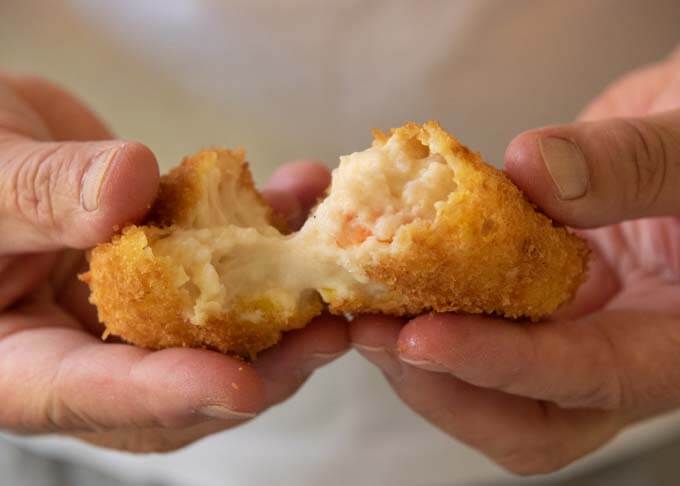
From the nutrition perspective, Creamy Shrimp Croquettes are slightly higher calories than Korokke (Japanese Potato and Ground Meat Croquettes), possibly because of the amount of butter and milk included in the béchamel sauce. But when you eat them you don’t find them heavy at all. They are actually quite light yet sufficiently rich.
Yumiko
![]()
P.S. Don’t forget to see the section ‘MEAL IDEAS’ below the recipe card! It gives you a list of dishes that I have already posted and the new recipe in this post that can make up a complete meal. I hope it is of help to you.

Béchamel based Creamy Shrimp Croquettes are as popular as Korokke (Japanese Potato and Ground Meat Croquettes) in Japan. They might look a bit fiddly but actually it does not take long to make them. Great to make ahead and freeze.
Unlike potato-based croquettes, you can enjoy the rich creamy flavour without pouring a sauce over the top.
Total Time does not include the time to chill the béchamel mixture.
- 150g/5.3oz fresh uncooked medium size prawns/shrimps in shell (note 1)
- 50g/1.8oz onion roughly chopped
- 300ml/10.1oz milk
- A couple of shakes of nutmeg powder
- 1 bay leaf
- ¼ tsp of salt
- Pepper
- 30g/1.1oz butter
- 40g/1.4oz flour
- 2 tbsp flour
- 1 egg , beaten
- 1 cup panko breadcrumbs
- Neutral oil (vegetable, canola) for deep frying
- Shredded cabbage
- 2 sprigs parsley
-
Add the Creamy Shrimp Mixture ingredients, except butter and flour, to a saucepan and heat over medium high heat.
-
When the outside of the milk starts bubbling, shake the pan occasionally so that the milk does not burn along the side of the pan.
-
When the milk starts simmering gently, turn the heat down to low and simmer for a minute or until the prawns become red and curled up.
-
Remove from the heat and leave for another minute. Put the milk through a sieve and reserve for béchamel sauce.
-
Let the prawns cool down a bit, then remove heads and peel the shells. Chop each prawn into 3-4 small pieces.
-
Melt butter in a frying pan over low heat.
-
Add flour and mix well. Cook for 3 minutes, stirring constantly ensuring the roux does not change colour.
-
Add 1/3 of the reserved milk and mix well to incorporate until lump free (note 2).
-
Add the remaining milk to the roux in two batches and mix well in the same way.
-
Add prawn pieces and mix to spread prawns evenly.
-
Transfer the mixture to a tray and shape it into a square or a rectangle of about 2.5cm/1” thickness.
-
Cover the surface of the mixture with cling wrap to prevent it from drying up. Let it cool down, then chill in the fridge for a couple of hours (note 3).
-
Divide the shrimp mixture into 6 equal portions.
-
Oil your hands and shape each portion into a fat log shape.
-
Place flour, egg and breadcrumbs individually in shallow plates or bowls.
-
Coat each piece with flour, egg, then breadcrumbs. Ensure that the surface of the croquette is well covered with the coatings otherwise the soft cream will ooze out from the gap while frying.
-
Heat oil in a deep fry pan to 175-180C/350F. Gently drop a few pieces in (note 4) and fry for a couple of minutes until the breadcrumbs become golden brown.
-
Transfer the croquette to a plate lined with kitchen paper to absorb the excess oil, or a tray with a rack.
-
Serve immediately with shredded cabbage and a stem of parsley leaves.
1. If you only have peeled prawns, you will need 80g. The prawn flavour in the milk will not be as intense.
2. If required, use a whisk to remove lumps.
3. You could chill it in the freezer too. As long as the béchamel mixture becomes cold and firm it will be OK to shape croquettes.
4. I used a small sauce pan to deep fry three croquettes at a time. After dropping one croquette in the oil, I placed another croquette on top of the one in the oil so that the croquette gently rolled into the oil.
5. You can freeze Creamy Shrimp Croquettes either before deep frying or after deep frying. Frozen croquettes keep about a month.
FREEZE BEFORE FRYING: Wrap each crumbed croquette in cling wrap and place them on a flat tray without overlapping. Once frozen, you can pile them up in a bag or a container to store.
To cook, defrost in a microwave for 1 minute (per croquette), then deep fry at 175-180C/350F until golden brown. Do not overcrowd the oil with too many croquettes.
FREEZE AFTER FRYING: Wrap each croquette in cling wrap and place them on a flat tray without overlapping. Alternatively, place croquettes without touching each other in a container with a lid and freeze. Once frozen, you can pile them up in a bag or a container to store.
To reheat, microwave for a minute (per croquette) to defrost, then place them on a tray lined with scrunched aluminium foil. Bake at 175-180C/350F for 15 minutes.
6. Nutrition per croquette, assuming that the amount of oil absorbed into a croquette is 10% of the weight of the croquette.
serving: 139g calories: 378kcal fat: 18g (28%) saturated fat: 3.3g (16%) trans fat: 0.1g polyunsaturated fat: 4.4g monounsaturated fat: 9.3g cholesterol: 40mg (13%) sodium: 284mg (12%) potassium: 203mg (6%) carbohydrates: 44g (15%) dietary fibre: 2.1g (8%) sugar: 1.9g protein: 9.6g vitamin a: 4.2% vitamin c: 1.9% calcium: 8.8 % iron: 15 %
Meal Ideas
A typical Japanese meal consists of a main dish, a couple of side dishes, a soup and rice. I try to come up with a combination of dishes with a variety of flavours, colours, textures and make-ahead dishes.
Although high in fat, Creamy Shrimp Croquettes do not contain a lot of protein, so I included Chicken Patties as a side (1-2 pieces per serving). Both the main and side dish 1 can be made ahead if time is limited on the day of serving. The soup does not have to be miso based but in either type of soup, try to pick light ingredients.
Daikon is a great company to the fried dish as it helps digestion. Sour plum dressing also goes well with the deep fried dish. But if you prefer, you can use other dressings.
- Main: Creamy Shrimp Croquettes – today’s recipe, can be made ahead
- Side dish 1: Chicken Patties Wrapped in Perilla – serve as a side, can be made ahead
- Side dish 2: Daikon Salad with Pickled Plum Dressing – instead of plum dressing, you could use Wasabi Dressing
- Soup: Tofu and Wakame Miso Soup – or any other soup of your choice
- Rice: Cooked Rice
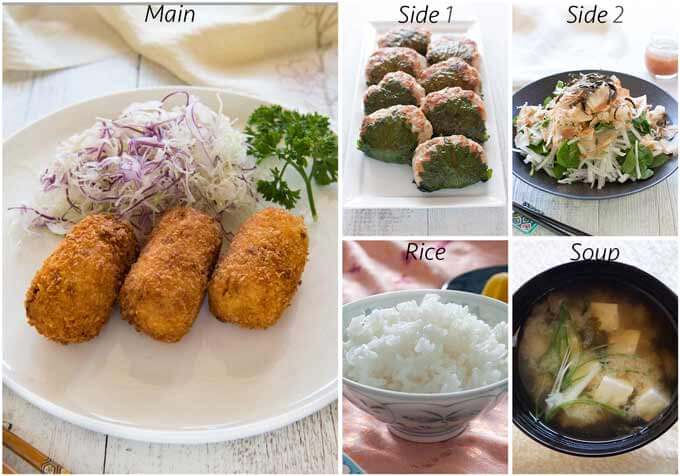
Yumiko, do you think it would work to shallow fry and then finish in the oven? I really don’t want to use all that oil for a deep fry.
Francesca
Hi Francesca, yes, you can do that. When shallow frying, make sure that you roll the croquettes from time to time to get them evenly cooked.
Thank you, I’ll give it a try!
Can these be air fried either as freshly chilled or frozen croqueta?
Or do you have to deep fry then can reheat in air fryer?
I want to take as tapa to cook at friends but do not want to take a deep fat fryer with me.
Hi Pauline, I don’t have an airfryer, but based on what I read about it, you should be able to do it either freshly chilled or frozen. You’d need to spray oil around the croquettes if you want to get it nicely browned and crunchy.
Thank you. I will give it a go and let you know?
Hi Pauline, please do. Looking forward to hearing from you.
Hi Yumiko, unfortunately mixture didn’t set for me to make croqueta for my tapas menu on Saturday. However, I went to plan B for dinner tonight by making crepes, filling with the shrimp cream sauce, then panko crumbing to bake in oven. Just as delicious!
I will try the recipe again but with additional roux for croqueta.
Thanks for the recipe as the infused milk is awesome idea.
Hi Pauline, I’m sorry that the sauce did not set hard enough. But your plan B sounds delicious. Next time when you make creamy croquettes, you might put the sauce in the freezer until it becomes semi-frozen.
Hi , I was wondering if you had ever tried cooking the day before and frying then reheating in the oven
The next day ?
Looking for something my daughter could warm up for her friends
Hi Sandra, I have reheated deep-fried creamy croquettes in the oven the day after I cooked them, so you can do it. If your daughter has a microwave as well as oven, the best way is to warm them up in microwave, then put them in the oven to crisp up the breadcrumbs.
Thank you Yumiko , also , do you use raw prawns in the shell or cooked prawn in the shell .
Thanks
Hi Sandra, raw prawns in the shell because they need to be cooked in milk. Thanks for asking, I just updated the recipe to clarify that.
Thank you Yumiko x
Hello Yumiko,
tried it the second time today. The first try was an absolute failure, way too thin. This time I measured the milk before and after cooking and removed about a 100ml than continued with the roux. After adding all the remaining milk it almost seemed a failure again. It was not firm enough to shape so I added about 3 tablespoons of flour (whole grain spelt flour) to make it firmer. It worked! And it is delicious! I used about 200g of precooked peeled shrimps.
Greetings
E.M.
Hi E.M., spelt flour is more water soluble than all-purpose flour, that’s probably the reason why you needed more flour for the same amount of milk. I’m glad it worked out this time and you enjoyed it!
I was lazy and just added all the Creamy Shrimp Mixture ingredients to the blender after sauteeing. That way I was sure to get all the taste of the shrimp shells 🙂
Hi Thomas. Really? It must have had a good shrimp flavour!